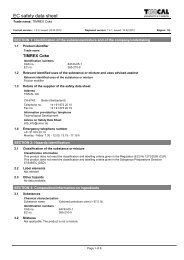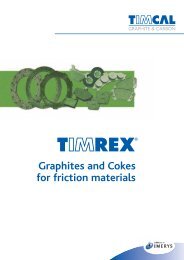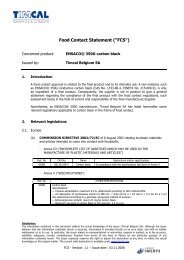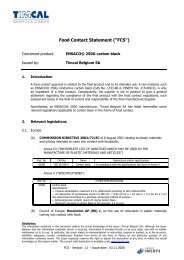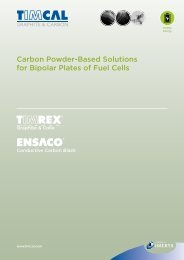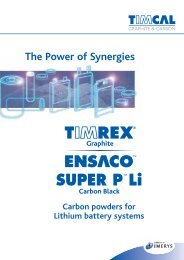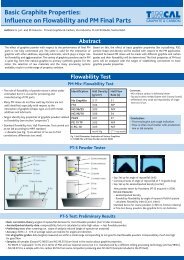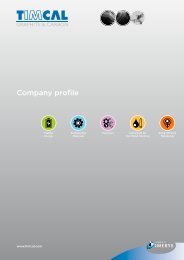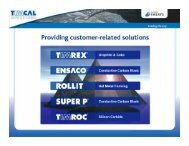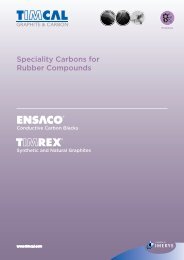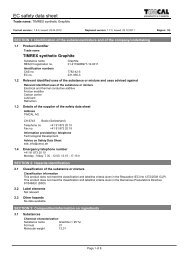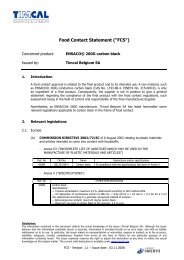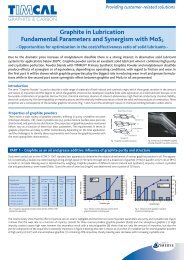Brochure: A Synopsis of Analytical Procedures - Timcal
Brochure: A Synopsis of Analytical Procedures - Timcal
Brochure: A Synopsis of Analytical Procedures - Timcal
Create successful ePaper yourself
Turn your PDF publications into a flip-book with our unique Google optimized e-Paper software.
<strong>Analytical</strong> procedures forTIMREX ® Graphite and CokeAsh contentA low-walled ceramic crucible is ignited at800° C in a muffle furnace and dried in adessicator.A sample <strong>of</strong> 10 g <strong>of</strong> dry powder (accuracy0.1 mg) is weighed in a low-walled ceramiccrucible. The powder is combusted at atemperature <strong>of</strong> 815° C (1472° F) to constantweight (at least 8 h). The residue correspondsto the ash content. It is expressedas a percentage <strong>of</strong> the initial weight <strong>of</strong> thesample.References:- DIN 51903 and DIN 51701 (dividing process)- ASTM C 561-91Water contentThe method is based on the chemicalreaction <strong>of</strong> water with sulphur dioxide andiodine (Karl Fischer Titration). We alsoemploy an alternative method where a sample<strong>of</strong> 30-70 g <strong>of</strong> carbon powder (accuracy0.1 mg) is weighed in a glass beaker anddried at 110° C (210° F) until constantweight is reached (approx. 8-10 h). T h eweight loss corresponds to the water content.It is expressed as a percentage <strong>of</strong> theoriginal weight <strong>of</strong> the sample.References:- DIN 51777 and DIN 51701- DIN 51904 - ASTM C 562-91- Eberius, Wasserbestimmung mit KF-Lösung,Verlag Chemie, Weinheim (1958)- Mitchell/SmithAquametryInterscience Publisher NY/London (1948)2003004005006007008009001000Trace elementsThis analysis is performed by an SDAROES Simultaneous emission spectrometer.Graphite powder, ground to a maximumparticle size <strong>of</strong> 80 µm by means <strong>of</strong> a vibratedmill is compacted to a tablet. The sampleis placed onto the excitation standunder argon atmosphere <strong>of</strong> the spectrometer.Subsequently the fully automatic analysiscan be initiated.References:- K. SlickersAutomatic Emission SpectroscopyBrühl Druck und Presshaus Giessen (D) (1992)- M. Wissler und P. GebhardtProtokoll der 29. Sitzung des Unterausschusses Festst<strong>of</strong>feim Arbeitkreis Kohlenst<strong>of</strong>f der Deutschen KeramischenGesellschaft (12./13. Dez 1984)Trace Elements -2 (XRF)Another possibility to determine traceelements concentration is using X-rayFluorescence Spectroscopy (XRF).The sample to be analyzed is compactedinto a 40 mm tablet at a pressure <strong>of</strong> 12tons. Multiple tablets are placed in a sampleloader which is placed inside the vacuumchamber <strong>of</strong> the XRF. Once the vacuumis established, each tablet is in turn exposedto an X-ray beam. To maximize the surfaceanalyzed, the tablets are slowly rotated duringexposure. The energy <strong>of</strong> the beamexcites the different atoms constituting thesample; when returning to their normalstate, these atoms emit characteristic X-rayfluorescence. Their specific energy levelsare analyzed by a Si-Li detector.For each element, the energy <strong>of</strong> the characteristicX-ray determines the nature <strong>of</strong>the elements while the number <strong>of</strong> counts <strong>of</strong>each characteristic X-ray allows for the calculation<strong>of</strong> the relative proportion <strong>of</strong> eachelement in the sample. The XRF analysisprocess is fully automated.Reference:- TIMCAL methodInterlayer spacing c/2The interlayer space c/2 is determined byX-ray diffractometry. The angular position<strong>of</strong> the peak maximum <strong>of</strong> the (002) and(004) reflection pr<strong>of</strong>iles are determinedand, by applying the Bragg equation, theinterlayer spacing is calculated.The graphite sample is mixed with a siliconstandard. A mixture <strong>of</strong> polyglycol andethanol is added in order to obtain a highlyviscous slurry. Subsequently, a thin layer <strong>of</strong>approx. 150 µm is applied to a glass plateand dried. A Cu Kα X-ray beam is used.References:- Klug and Alexander, X-Ray diffraction <strong>Procedures</strong>John Wiley and Sons Inc., New York London (1967)Crystallite size LcCrystallite size is determined by interpretation<strong>of</strong> the (002) and (004) diffractionpr<strong>of</strong>iles. However, the analysis is somewhatproblematic in view <strong>of</strong> the fact that texture(e.g. porosity) tends to superimpose theangular pr<strong>of</strong>ile. Several methods have been<strong>of</strong>fered to calculate the line broadeningwhich should be affected by crystallite sizealone.TIMCAL has chosen the approach suggestedby Iwashita. The algorithm proposedby Iwashita has been specifically developedfor carbon materials.The widths <strong>of</strong> the line pr<strong>of</strong>iles at the halfmaximum <strong>of</strong> sample and reference aremeasured. By means <strong>of</strong> a correction function,the width <strong>of</strong> pure diffraction pr<strong>of</strong>ilecan be determined. The crystallite size issubsequently calculated by applyingScherrer's equation.References:- P. Scherrer, Göttinger-Nachrichten 2 (1918) S.98- N. Iwashita, C. Rae Park, H. Fujimoto, M. Shiraishiand M. Inagaki, Carbon 42, 701-714 (2004).13012011010090807060504030



